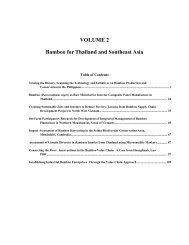WBC-VIII-Vol.4 – Resources – Forestry, Plantations and ... - BambuSC
WBC-VIII-Vol.4 – Resources – Forestry, Plantations and ... - BambuSC
WBC-VIII-Vol.4 – Resources – Forestry, Plantations and ... - BambuSC
Create successful ePaper yourself
Turn your PDF publications into a flip-book with our unique Google optimized e-Paper software.
Abstract<br />
Distribution <strong>and</strong> Assessment of Bamboo<br />
in South Kordofan State, Sudan<br />
Ahmed M A Eldoma, 1 Eiman E. E. Diab 2 <strong>and</strong> Gamal Eldien M Abbakar 3<br />
1 Sudan University for Science <strong>and</strong> Technology, Faculty of <strong>Forestry</strong> <strong>and</strong> Range Science, Khartoum, Sudan<br />
2 Institute of Environment <strong>and</strong> Natural Recourses, National Centre for Research, Khartoum, Sudan<br />
3 Forests National Corporation, South Kordofan State, Kadogli, Sudan.<br />
An inventory <strong>and</strong> assessment of bamboo was carried out in eight different sites in South Kordofan State of the<br />
Sudan. The common bamboo species growing in the area is Oxytenanthera abyssinica. However, Findings of<br />
the present study revealed the occurrence of a second bamboo species in some forest sites inventoried viz.<br />
Sinarundinaria alpina. It has not been commonly known before to be indigenous to South Kordofan. Results<br />
obtained indicate significant differences between the forest sites in stocking <strong>and</strong> other growth characteristics. In<br />
this connection, stocking ranged from 305 to 1100 clumps/ha. These differences may be attributed to over<br />
exploitation as related to proximity or remoteness from populated areas. The study emphasized the importance<br />
of further research work <strong>and</strong> development of the country’s bamboo resource at large <strong>and</strong> particularly South<br />
Kordofan, the Blue Nile <strong>and</strong> South Darfur States where bamboos are naturally growing.<br />
Introduction<br />
Sudan is one of the largest African countries. It covers approximately 2.5 million km 2 . It is located between<br />
latitude 4 - 22 0 N <strong>and</strong> Longitude 22 - 36 0 E. (Fig 1). The forest resources endowment of the country is highly<br />
diverse ranging from mere desert scrub at the northern frontiers to very rich savannah <strong>and</strong> pockets of tropical<br />
rain forest in the southern parts of the country. Even though Sudan is not rich in its forest resources but the fact<br />
remains that it is one of the African countries having potentialities of diversified forest products. Bamboo is one<br />
of several forest resources of the country that has received only very meager attention. Only very little <strong>and</strong><br />
fragmented efforts were made to assess the bamboo resources of the country. The problem of proper<br />
management <strong>and</strong> maintenance of the remaining bamboo forest resource has been strongly emphasized in<br />
conjunction with the present day deterioration of the natural forests of the country as a result of over exploitation<br />
<strong>and</strong> desertification (Elhouri et al. 2001). Vast areas of natural forests of South Kordofan include bamboo as an<br />
integral part of them. Consequently, information is needed on the bamboo resource as a prerequisite for proper<br />
planning, sustainable management, maintenance <strong>and</strong> protection. Andrews (1950) <strong>and</strong> Khan (1966) have reported<br />
that Oxytenathera abyssinica is the only bamboo species that grows in the Sudan as indigenous species. This has<br />
been further supported by Kigomgo (1988), Elamin (1990) <strong>and</strong> Hashim (1997). However they reported that<br />
another bamboo species viz. Sinarundinaria alpina which was formerly known as (Arundinaria alpina ) is<br />
naturally growing in the upper reaches of the Imatong mountains in Sothern Sudan. Phytogegraphically, bamboo<br />
<strong>VIII</strong> World Bamboo Congress Proceedings Vol 4-97




